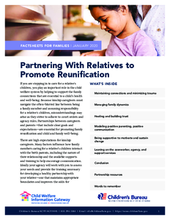Displaying 41 - 50 of 154
A documentary from UNICEF Ghana on the work of BRAVEAURORA in order to raise awareness about the harm of residential care.
The child protection in emergencies (CPiE) capacity gaps analysis (CGA) in the West and Central Africa (plus Mauritania) region, targeting CPiE practitioners with 3-5 years of professional experience, aimed to collect and provide information on (1) identified key CPiE capacity gaps and (2) existing and available capacity building initiatives.
This factsheet shares the experiences and advice of families who have had relatives in
kinship care arrangements to highlight the dynamics and steps that can support reunification.
This report delves into the differences between boys’ and girls’ experiences through a gendered analysis of the six grave violations of children in conflict, including recruitment of children by armed forces and child abduction. The report makes reference to the vulnerabilities faced by girl heads of household or unaccompanied and separated girls on the move and calls for interventions such as family tracing and reunification, the provision of alternative care for unaccompanied and separated children, and the release and reintegration of children associated with armed forces and armed groups.
This brief - a supplement to the Stop the War on Children 2020: Gender matters report - highlights the situation of children in conflict zones in West and Central Africa with a focus on gender.
This article investigates how forced migrants residing in Finland utilise different types of resources in their efforts to reunite with their families.
This compilation contributes to the implementation of the objectives of the Action Plan on protecting refugee and migrant children in Europe, adopted by the Committee of Ministers of the Council of Europe, by bringing together international and European standards on child-friendly practices in the context of migration with illustrations from practice of the kind of initiatives, programmes and procedures that serve to implement these standards.
The aim of this module from the book Rights-based Integrated Child Protection Service Delivery Systems is to learn about the child protection services needed during armed conflicts.
The aim of this module from the book Rights-based Integrated Child Protection Service Delivery Systems is to learn about children in specific situations of emergency and the need for Integrated Child Protection Centres to provide rights-based services for them at primary, secondary and tertiary levels of prevention.
This report from Save the Children provides an overview of the impacts of armed conflict on children, the efforts that Save the Children and others are making to address the needs of children affected by armed conflict, and a series of recommendations for governments and others.







